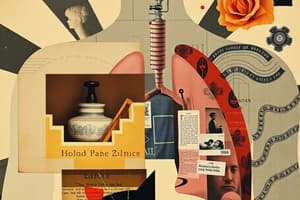Podcast
Questions and Answers
What is the process of transporting oxygen from the lungs into the bloodstream while removing carbon dioxide known as?
What is the process of transporting oxygen from the lungs into the bloodstream while removing carbon dioxide known as?
Gas exchange
Where do oxygen molecules reach after passing over the moist lining of the nose, throat, and bronchial tubes?
Where do oxygen molecules reach after passing over the moist lining of the nose, throat, and bronchial tubes?
Alveoli
What is the function of the thin membrane walls of alveoli?
What is the function of the thin membrane walls of alveoli?
Allows easy passage for oxygen to enter the blood vessels surrounding them
What picks up the oxygen in the alveoli?
What picks up the oxygen in the alveoli?
How is carbon dioxide eliminated from the body?
How is carbon dioxide eliminated from the body?
What serious health problems can occur without proper gas exchange?
What serious health problems can occur without proper gas exchange?
Flashcards are hidden until you start studying
Study Notes
Oxygen and carbon dioxide are two vital gases involved in our body's respiratory system. This process of transporting oxygen from the lungs into the bloodstream while removing carbon dioxide is known as gas exchange. Here we will explore how these two gases move through various parts of your body, starting with their journey from the air you breathe.
When you inhale, oxygen molecules pass over the moist lining of the nose, throat, bronchial tubes, and finally reach small sacs called alveoli inside the lung tissue. These tiny sacs have walls made of thin membrane that allows easy passage for oxygen to enter the blood vessels surrounding them. At this point, red blood cells pick up the oxygen, which they carry throughout your body. On the other hand, when you exhale, the waste product carbon dioxide leaves your body. Carbon dioxide moves out of your body by being carried along the veins back to your heart, where it enters your circulation and can eventually leave your body when you next exhale.
The process of gas exchange occurs in three steps: firstly, inspired gas enters your bloodstream; secondly, some of it gets absorbed by the tissues; thirdly, the expired gas goes back outside the body. This cycle happens continuously, ensuring your body has a constant supply of fresh oxygen and elimination of carbon dioxide. Without proper gas exchange, serious health problems such as hypoxia (low oxygen levels) or hypercapnia (high carbon dioxide levels) can occur. However, under normal conditions, the respiratory system performs this function effectively and efficiently.
Studying That Suits You
Use AI to generate personalized quizzes and flashcards to suit your learning preferences.




